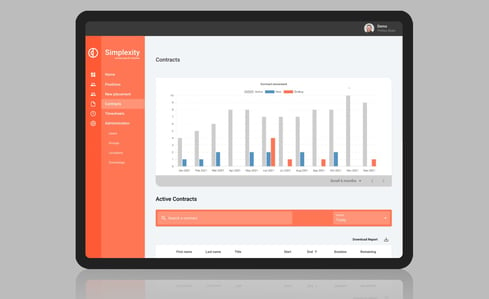Tax Structures for Contractors – What’s Right for Me?
As a contractor, you’re offered a degree of freedom that salaried employees simply don’t have. This includes choosing the tax structure under which you operate. These structures stipulate the rules and regulations you must abide by when filing your taxes at the end of the financial year. They can also have significant impacts on how you operate your business, so choosing the one best suited to you is vital.
What are my options?
Broadly, tax structures fall mostly into one of two camps – pay-as-you-go (PAYG) or proprietary limited company (Pty Ltd).
Under a PAYG arrangement, a contractor enjoys benefits similar to a company employee where someone else is managing their tax and super obligations. In the contractor’s case, this is done typically by an agency or a contractor management company that takes care of their payroll.
Payment from clients is made directly to the contractor management company which then packages your salary – subtracting their management fee and withholding tax from the gross before depositing the rest into your account.
If you choose this structure, you are still free to source your own clients, use your own tools, maintain your office and operate as agreed in your individual contract.
- Variable headline tax rate between 0 and 45% depending on income
- Mandatory super contributions
- No requirement to purchase own business insurance
Should you choose Pty Ltd, you are trading as a company with yourself as director & shareholder. You are wholly responsible for sourcing your own clients and managing your own funds – just as if you were the owner of a brick-and-mortar business. (working arrangement is similar as PAYG, i.e. they source their work, follow end client’s instructions, etc.)
As a Pty Ltd, your income is subject to different tax rates and reporting requirements Pty Ltd is attractive for some contractors as they have greater control over their cash-flow.
- Tax rate of 27.5% below $25 million aggregated turnover (30% otherwise)
- Greater flexibility in superannuation contributions
- Must provide your own business insurances at your expense
FAQs – We spoke to accountancy advisor Chintan Shah of SC Partners about the questions he gets asked the most by contractors - How can I save tax?
Many contractors begin the discussion around tax structures with a view to tax minimisation, but Chintan was quick to point out that this can’t be an end in itself.
“I’d steer away from looking at minimising tax in itself and look at the contractor’s broader situation,” he said.
“It’s important to establish the overall strength of their balance sheet first – mortgage and other debts, liquidity, income, tax liability, etc – before determining what their real goals are.
“Whether it’s paying off a mortgage, paying for a private education for their children, growing their property portfolio, this has to be the focus.”
This broader view is essential as it not only impacts which tax structure you pursue, but also affects a range of other financial considerations. For example, if you’re looking to invest in property, not only will that affect your choice of tax structure but also how and where your money is invested, and the amount of upfront capital you’ll require.
“For someone in that situation I’d recommend a Pty Ltd structure,” Chintan said.
“You’ll enjoy a great deal of extra flexibility in how you spend your money because you have flexibility in managing your tax and super obligations, which could put thousands of dollars back in your pocket.”
He was quick to point out that the PAYG structure has its advantages as well.
“If you’re well off, I sometimes suggest staying with PAYG. If you’ve got no financial pressures, why lose that stability and safety?”
Can I operate as a company because of the 80/20 rule?
A common misconception amongst white-collar contractors is that if they’re drawing the majority of their income from a single client, they can’t operate as a company. This notion stems from a misunderstanding of a complex piece of tax regulation put in place by the ATO referred to as the 80% rule. Under the 80% rule, should you draw more than 80% of their income from a single client, it may be classed as Personal Services Income (PSI).
Should this be the case, there are two key implications for your tax situation. First and foremost, triggering the PSI Provisions means that all income received in your chosen business structure must be recorded in your personal tax return.
Chintan noted that this was because of the differing ways in which tax rates are calculated between individuals and corporations.
“If my work through my company earns me $200,000 and I was solely responsible for its delivery, the ATO will consider this all Personal Services Income as it was my experience and skills that allowed me to complete the work,” he said.
“For this reason, a contractor’s tax liability will be similar as PTY LTD or PAYG unless of course, they use proactive tax planning strategies.
“PSI provisions are put in place to ensure a contractor earning personal services income is not able to reduce their personal tax liability by simply distributing a portion of their income to their spouse or any other associate who is on a low-income tax rate.”
Additionally, Chintan noted that contractors subject to PSI Provisions are forbidden from claiming a number of tax deductions including rent, mortgage interest, payments to associates and car expenses for more than one vehicle, amongst others.
Note that should your business satisfy three requirements under a results test – you are required to produce a specific result or outcome before being paid, you are required to provide your own equipment or tools, and you are required to fix mistakes at your own cost – the Personal Services Income Provisions and the above implications will not apply to your income.
How does each tax structure affect my home loan suitability?
Under the right circumstances, a contractor on a PAYG structure and a contractor on a Pty Ltd structure on the same income are equally attractive to the same bank. Where they differ is in a number of additional tests the institution will apply to the Pty Ltd contractor.
In a nutshell, banks assess Pty Ltd contractors as being at greater risk of default than PAYG contractors due to the wholly self-employed nature of their work. As such, Chintan advised caution for anyone looking to both buy a house and shift to a Pty Ltd structure within the same year.
“When I work with contractors to help them secure a mortgage, we have a panel of around 20 lenders we go to,” he said.
“If you’ve switched to a Pty Ltd structure within the last six months, most of those lenders will immediately strike you off because you’re self-employed with less than two years financial history under this structure.”
This isn’t a death sentence for any contractor looking to become a homeowner. Chintan noted that it was all about timing.
“With two years of history operating as a Pty Ltd, your loan suitability looks similar to that of someone in your position on a PAYG income,” he said.
“Even a 12-month timeframe to buy a house means that loans are likely to not be an issue.”
But what if you’re drawing a higher gross income on a Pty Ltd structure? Shouldn’t that help? According to Chintan, unfortunately not.
“With so little history, the bank will assess your borrowing capacity based on your previously drawn PAYG income rather than your new Pty Ltd income.”
Therefore, if you are considering purchasing a home or property within the next 12 months, it may be advisable to delay shifting to a Pty Ltd structure until after you have completed the settlement.
Answering your questions
Want to know more about how you can get the most from your new life as a contractor? Contact Oncore today and we’ll be happy to connect you to our accountancy partners to discuss the best structure for your situation.












_11zon%20(1).jpg?width=302&height=124&name=linkedin-sales-solutions-vqWWOnA6--M-unsplash%20(2)_11zon%20(1).jpg)






